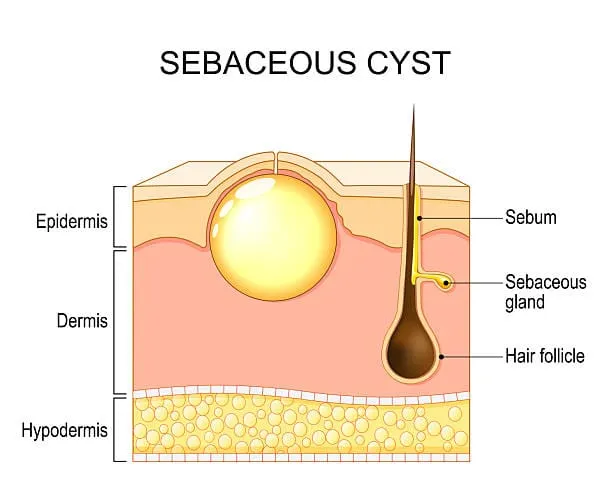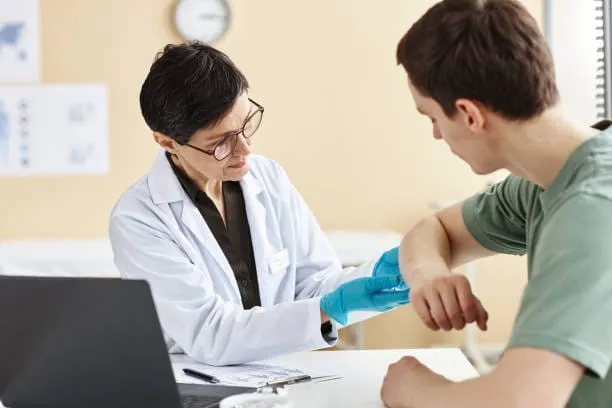Everything You Need to Know About Sebaceous Cyst Removal: Causes, Procedure & Recovery
Understanding Epidermoid and Sebaceous Cyst Removal
It is normal for many people to get sebaceous and epidermoid cysts, which are common types of skin lumps often treated through sebaceous cyst removal. Most of the time, cysts are harmless, but at times they can cause people pain, swelling or Disease. It is essential to be aware of the differences between sebaceous and epidermoid cysts, the removal methods and what will happen each step of the way if you are thinking about cyst removal.

A blocked sebaceous gland causes a sebaceous cyst, which grows slowly and feels firm, containing oily substances. These cysts, which are sometimes called sebaceous cysts, appear when skin cells get trapped, and the material that builds up inside is keratin. You may find both cyst types on the face, neck, scalp or body, and they can be different sizes.
It will give you advice on the most effective ways to treat sebaceous and epidermoid cysts. You will find out about the available Treatments procedures, how long you can expect to heal, possible risks and how a professional can make sure the treatment works well and safely. Cysts can usually be taken out with therapy so that it causes as little discomfort and scarring as possible.
We provide custom cyst removal treatment at Revitalise London, which helps you restore your skin to be healthy, smooth and free from all kinds of concerns.
Types of Sebaceous and Epidermoid Cysts
It helps to know the types of skin cysts before planning any treatment. Although many people call every skin cyst a sebaceous cyst, there are sebaceous cysts and epidermoid cysts. Though they look alike, these conditions are caused by different things, display different symptoms and need different treatments.
What Are Sebaceous Cysts & How Sebaceous Cyst Removal Done
Such cysts are formed when the sebaceous glands, which make oil (sebum) beneath the skin, become blocked. The blockage causes sebum to build up, and this sebum appears as a smooth, round lump under the skin. It is common for sebaceous cysts to have a punctum, a tiny hole in the centre, and they may be as small as a few millimetres or as large as several centimetres.
Oily skin areas are often where these problems appear, such as on the:
- Scalp
- Face
- Neck
- Chest
- Back
Although these cysts are usually harmless, they may become red, swollen or hurt, generally if they get contaminated. In such cases, sebaceous cyst removal becomes more than a cosmetic decision—it’s a medical necessity to prevent complications like abscesses or scarring.
What Are Epidermoid Cysts?
Sometimes, skin cells that are supposed to shed are trapped, start growing and create epidermoid cysts beneath the skin. They build up the cyst’s wall and start secreting keratin, which fills the sac and causes it to get bigger. About 90% of all mucous cysts are mistaken for sebaceous cysts since they have similar appearances.
Common areas where epidermoid cysts appear include:
- Face
- Neck
- Shoulders
- Trunk
Though benign, these cysts can become contaminated or inflamed. Just like sebaceous cyst removal, the best approach is often a minor Treatments procedure, especially if the cyst keeps recurring or causes discomfort.
Why Differentiating Matters
The way you are treated may be different for sebaceous and epidermoid cysts. Specialists look into the source to decide on the most appropriate way to remove fibroids or cysts, which can be done through minor Procedure.
At Revitalise London, our skilled practitioners assess the type of cyst you have before recommending the most suitable sebaceous cyst removal procedure. It helps make treatment safe, clean and efficient so that the problem is unlikely to return.
Sebaceous Cyst Removal Methods Explained
Though sebaceous cysts can look harmless, if they get contaminated, inflamed or unattractive, seeing a doctor to have them removed is often the best choice. At Revitalise London, we offer several safe and effective sebaceous cyst removal methods. Every procedure is matched to your skin type, the size of your cyst and where it is, which makes it easier on you and more effective

1. Treatments Excision
This is the most common method for sebaceous cyst removal. Local anaesthetic is used, and the specialist cuts into the cyst and takes out the entire sac and what is inside. This ensures the cyst doesn’t return.
- Advantages: Cysts rarely come back, and this works for both large and recurring ones
- This is for: Sebaceous cysts that you find on the scalp, back or similar thick skin areas
- Healing time: 1 to 2 weeks
2. Minimal Excision Technique
The cyst’s contents are taken out through a small cut, and the Doctor tries to extract the cyst wall through the same opening.
- Pros: Smaller scar, faster healing
- Best for: Smaller or less inflamed sebaceous cysts
- You might have a slightly higher risk of the sac returning if it is not entirely taken out.
3. Laser-Assisted Cyst Removal
Laser treatment is a newer and less invasive option. The doctor may use a laser to make the initial opening and also to reduce the size of the cyst before taking it out. This results in less bleeding and a cleaner wound.
- Pros: Precise, minimal damage to surrounding tissue
- Works Best: On easily irritated parts such as the face or neck
- Important: It is not recommended for huge or contaminated cysts
4. Incision and Drainage
If the cyst is contaminated, in some cases, the entire removal cannot be done right away. The cyst is drained, and you might be given antibiotics for treatment. Once the Disease clears, a complete sebaceous cyst removal can be scheduled.
- Pros: Controls Disease, relieves pain
- Cons: The cyst might come back if the sac isn’t removed in future
Choosing the Right Method
The best method for sebaceous cyst removal depends on many factors, including the cyst’s condition and your personal preferences. The team at Revitalise London always makes safety, comfort and appearance their primary goals. We will explain each step and make sure you know your treatment choices.
Does Sebaceous Cyst Removal Hurt? What You Need to Know
One of the most common concerns about sebaceous cyst removal is whether the procedure hurts. The good news? Patients at Revitalise London usually feel less pain, and it is managed by the clinic’s specialists.
Before the Procedure: Local Anaesthesia for Comfort
They will first numb the area you are having treated with an anaesthetic before starting. So you do not have to worry about pain during the procedure. Even though there is some sensation or movement, it’s painless and comfortable.
Very quickly, the anaesthesia numbs the area, and you stay comfortable even after the procedure is finished.
During the Sebaceous Cyst Removal
Every method, be it a significant cut, a small cut or using a laser, the anaesthetic means the procedure is painless. Most clients say that the experience is odd but not uncomfortable. A few people said they could feel a gentle pull or tug while the cyst was being extracted.
When your cyst needs to be drained first because it is contaminated, you might feel more sensitive, though an anaesthetic will still protect you from pain during this step.
After the Procedure: Mild Discomfort, Not Pain
After the numbness from the anaesthetic goes away, you could feel some mild discomfort, swelling or tenderness at the site. You can handle this type of pain with paracetamol or ibuprofen, which are available over the counter.
A cold compress can be used to lessen swelling and relax the area. Most people go back to their usual activities within 1 to 2 days.
When to Contact Your Clinic Sebaceous Cyst Removal
Pain beyond mild discomfort isn’t typical. If you experience increased redness, pus, or persistent pain after sebaceous cyst removal, contact your clinic immediately—it could be a sign of Disease.
At Revitalise London, we prioritise your comfort and safety. Experienced staff make sure every step in your treatment is given attention and care.
Aftercare Tips for Sebaceous Cyst Removal Recovery
Proper aftercare is essential to ensure your skin heals well after sebaceous cyst removal and to reduce the risk of Disease or scarring. Every client at Revitalise London is walked through an efficient and easy-to-follow recovery program.
1. Keep the Area Clean and Dry
When the procedure is over, the treated spot will be sealed with a sterile bandage. Keep the area around the wound clean and make sure it’s dry for the first 24–48 hours. Keep the wound dry when showering by covering it with a waterproof dressing.
Clean the spot with warm water and a mild soap, and then gently dry it off. Put on any topical medication your clinician recommends if it is available.
2. Change Dressings Regularly
Change your bandage daily or as instructed. Never touch the wound without first washing your hands, and do the same after touching it. Wound dressings that are fresh and clean lower the chance of Disease and let wounds heal more quickly.
3. Avoid Strain and Friction
Do not wear anything too tight on the spot where you got the Procedure, and avoid any activity that might rub or strain the wound. If your cyst showed up in a place where clothing or movement rubs often (such as the underarms or inner thighs), give your body more time to heal and treat it gently.
4. Watch for Signs of Disease
A small amount of redness, swelling or tenderness will occur, but a rise in temperature with pus should be brought to your clinic’s attention straight away. Early intervention prevents complications.
5. Let Scabs Heal Naturally
Keep away from picking or scratching the scab. This can delay healing and increase scarring.
6. Follow-Up is Key
Attend your follow-up appointment if scheduled. The practitioner will check that the cyst is entirely removed and that healing is underway.
By following these simple steps, you’ll support a smooth and comfortable recovery after sebaceous cyst removal.
Healing Timeline: What to Expect After Sebaceous Cyst Removal
Understanding the healing process after sebaceous cyst removal helps reduce anxiety and ensures a smoother recovery. Even though recovery periods differ based on the cyst’s size, site and the person’s health, many people had the same sequence of recovery.
First 24 to 48 Hours
In the first days of treatment, it is normal to have slight swelling, tenderness or redness near the treated area. This is normal and usually subsides quickly. Clean the area, let it dry and follow all the advice your clinician gives you.
When given antibiotics or pain relievers, use them exactly as instructed. Do not do anything that may cause you to sweat or put extra stress on the Procedure site.
Days 3 to 7
Usually, the initial stage of inflammation is now easing. A scab may cover the wound if there were no sutures, or the stitches will still be present if they were used. You may start doing routine daily tasks, but avoid anything that causes discomfort or rubbing.
Keep cleaning and changing your dressings once a day and watch out for signs of Disease, for example, increased pain, drainage or extra swelling.
Weeks 2 to 4
Non-dissolvable stitches are usually taken out about 7 to 10 days following the Procedure. The wound starts to heal, and it is easier to notice scarring. Patients will often see their symptoms improve a lot and feel little discomfort as the procedure continues.
You are able to do most activities, but should avoid any strong exfoliants or chemicals at the treated site.
One Month and Beyond
Most people achieve complete healing within 3–4 weeks. With correct skincare and sun protection, the appearance of scar tissue can be reduced over several months. Healing might be delayed if the cyst is under the skin or very big.
With proper aftercare, recovery from sebaceous cyst removal is typically straightforward and low-risk.
Sebaceous Cysts May Come Back After Being Removed
One of the most common concerns patients have after sebaceous cyst removal is whether the cyst will return. The way the cyst was removed and the technique applied during Procedure affect how much scarring will occur.

Complete Removal of the Sac Is Key
A blocked sebaceous gland causes sebaceous cysts, which are made of keratin. Because these cysts are in a sac, if the sac is not also taken out, the cyst may grow again.
At our clinic, we take out the cyst and its sac completely, so there is less of a risk of the problem returning. This is why we suggest going to a professional instead of using home remedies, which usually empty the cyst but do not remove the sac.
What Increases the Risk of Recurrence?
A number of things can make it more likely that a cyst will return.
- Incomplete removal of the cyst sac
- Disease before or during the procedure
- Excess pressure or trauma to the healing site
- Poor aftercare or hygiene post-treatment
Picking a skilled clinic and attentively following their advice after the treatment can significantly cut the risk of repeat Procedure.
What If a Cyst Does Come Back?
There are rare circumstances where a sebaceous cyst will show up again in the same place even after proper Procedure. If this happens, a repeated procedure may be necessary. You should come in for another visit if you see any changes, such as a tiny lump or if you feel discomfort under the skin.
Taking care of cysts properly the first time will decrease your risk of them returning.
Ways to Prevent the Formation of Sebaceous and Epidermoid Cysts
Even though everyone can get sebaceous or epidermoid cysts, you can take steps to lower your risk, especially if you have oily skin or blocked pores. Knowing the usual causes of these cysts means you can prevent them and not need further treatments.
1. Maintain Good Skin Hygiene
Regularly washing your skin clears out excess oil, sweat and dead skin, which helps prevent the clogging of sebaceous glands. Use a gentle, non-comedogenic cleanser daily, especially after sweating.
2. Avoid Squeezing Pimples or Bumps
Squeezing a cyst, pimple or blackhead can injure the surrounding skin and clog sebaceous glands, which might result in more cysts appearing. Always let a professional handle extractions.
3. Exfoliate Gently
Using a gentle exfoliator once or twice every week can stop your pores from getting blocked. Yet, stay away from harsh scrubs and extreme exfoliation, since they might irritate the skin and aggravate oil gland issues.
4. Treat Acne Early
Properly treat your acne-prone skin as soon as you notice it. If acne goes untreated or becomes inflamed, cysts or nodules may develop, and those can be removed by Procedure.
5. See a Professional for Unusual Lumps
Any lump or bump under your skin should not be ignored; see a doctor before it gets contaminated or painful. A short check-up can tell if the lump is a cyst and if any action is required.
Revitalise London, we not only offer expert sebaceous cyst removal but also guide you on how to keep your skin healthy and prevent future cysts from forming.
Why Choose Revitalise London for Sebaceous Cyst Removal
Removing sebaceous or epidermoid cysts is safe, effective and cosmetically mindful when done at a clinic like Revitalise London. Minor surgeries, for example, cyst removal, are performed at our clinic, and we are famous for offering precise and effective treatments with the least scarring.
Sebaceous Cyst Removal & Personalised Consultations
Every skin type is unique, and so is every cyst. The first step at Revitalise London is a full consultation to check the size, place and condition of your cyst. We guide you on the right way to remove your skin, and we make sure to answer your questions patiently.
Skilled Practitioners For Sebaceous Cyst Removal
Our experts in dermatology handle minor skin operations, for example, removing sebaceous and epidermoid cysts. We use Procedure to take out an inflamed, painful or cosmetic cyst to prevent it from returning.
Sebaceous Cyst Removal With Clean, Clinical Environment
We adhere to the highest hygiene and safety standards. Sterilised tools and procedures tested and approved by doctors are used in a safe and comfortable environment. As a result, there is a lower danger of Disease after Procedure, and patients heal faster.
Our Medical Team
Meet the experienced professionals who will provide your care
Nathalie Emmanuel
Actress - Game of Thrones Star
Had a wonderful experience with Dr Ken and his staff with my forehead lipoma removal. Thorough in planning before the procedure and so far, l've had a great experience with aftercare. When I had any questions there was always someone available to answer them.





